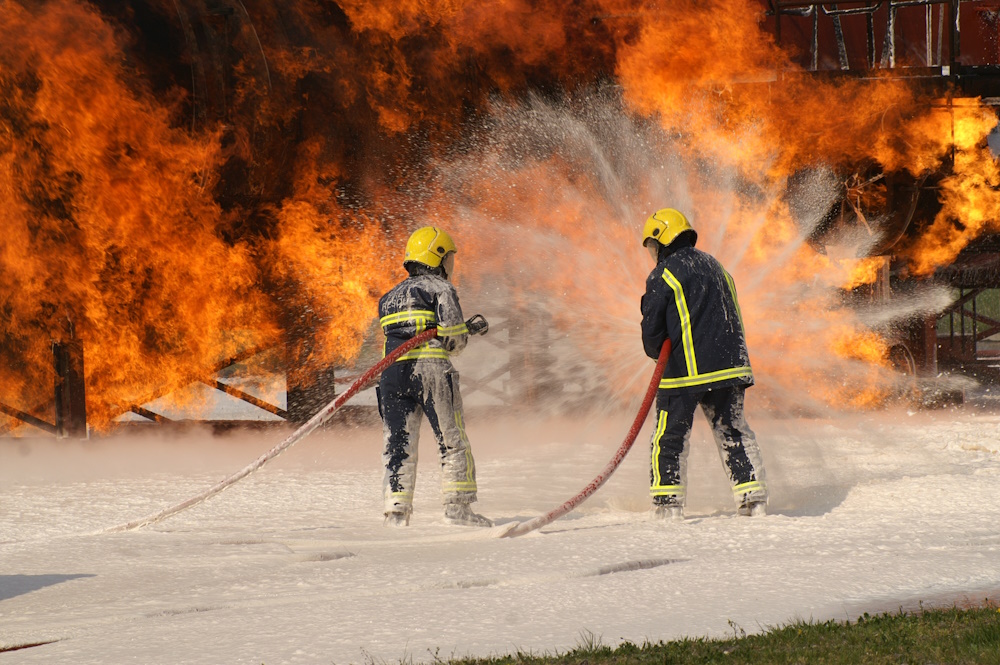Aqueous Film-Forming Foam (AFFF) is a crucial component in firefighting, revered for its remarkable ability to swiftly and effectively suppress flammable liquid fires. Composed of water, fluorosurfactants, and foam stabilizers, AFFF blankets the surface of a fire, smothering it and preventing reignition. However, a complex narrative of potential health hazards lies beneath its lifesaving capabilities.
In recent years, the spotlight has shifted toward the adverse effects of AFFF exposure on human health. Firefighters, military personnel, and civilians alike have found themselves inadvertently exposed to AFFF’s chemical constituents, raising concerns over long-term health implications. The inherent toxicity of per- and poly-fluoroalkyl substances (PFAS) present in AFFF formulations has sparked a growing body of research into its association with various health risks, including cancer, reproductive issues, and immune system dysfunction.
As veterans and individuals affected by AFFF exposure seek avenues for recourse and support, understanding the associated VA disability implications becomes essential. Let’s delve into more.
Understanding AFFF
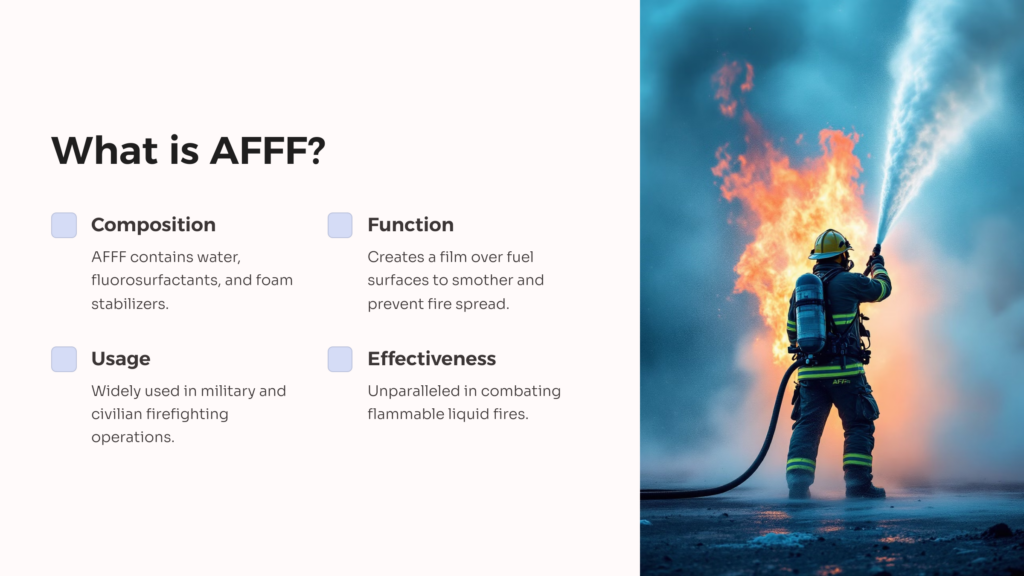
Aqueous Film-Forming Foam (AFFF) is a cornerstone in the firefighting and fire suppression arsenal, revered for its unparalleled efficacy in combating flammable liquid fires. AFFF, a specially formulated firefighting foam, creates a blanket-like film over the fuel surface, effectively smothering the fire and preventing its spread. This remarkable ability to rapidly extinguish hazardous fires has cemented AFFF’s status as a critical component in worldwide civilian and military firefighting operations.
At its core, AFFF comprises a precise blend of water, fluorosurfactants, and foam stabilizers, meticulously engineered to optimize its fire-suppressing capabilities. The fluorosurfactants within AFFF are critical to its functionality, as they reduce the surface tension of water, enabling it to spread rapidly across the fuel surface and form a cohesive barrier against combustion. Meanwhile, foam stabilizers work in tandem to enhance the foam’s durability and persistence, ensuring sustained fire suppression even in challenging conditions.
The manufacturing process of AFFF involves stringent quality control measures to guarantee consistency and effectiveness. Initially, raw materials undergo rigorous testing to ensure compliance with strict safety and environmental standards. These materials are then carefully blended and mixed to achieve the desired chemical composition, with precise attention paid to the proportions of fluorosurfactants and foam stabilizers. The resulting concentrate is typically stored in specialized containers or transported in bulk to firefighting facilities, where it can be diluted and deployed as needed.
AFFF’s ubiquitous presence can be attributed to its unparalleled versatility and reliability in addressing various fire hazards encountered in military operations. Military installations, aircraft carriers, naval vessels, and airfields often operate in environments where the risk of flammable liquid fires is heightened, necessitating robust fire suppression capabilities. AFFF’s ability to swiftly and effectively extinguish such fires makes it indispensable for safeguarding personnel, equipment, and critical infrastructure in military settings.
Moreover, the military’s stringent adherence to safety protocols and regulatory requirements underscores the importance of utilizing firefighting agents that meet the highest standards of efficacy and reliability. AFFF’s proven track record in mitigating fire-related risks and its compatibility with military equipment and protocols solidifies its status as the firefighting foam of choice for military applications.
AFFF’s comprehensive understanding reveals its role in civilian and military firefighting operations. From its engineered composition to its widespread adoption in addressing flammable liquid fires, AFFF stands as a testament to human ingenuity in confronting one of the most formidable challenges of modern firefighting.
Potential Health Risks Associated with AFFF Exposure
Scientific research conducted by the United States Environmental Protection Agency over the past few decades has shed light on the potential health risks associated with exposure to Aqueous Film-Forming Foam (AFFF), mainly due to its composition containing per- and poly-fluoroalkyl substances (PFAS). PFAS are synthetic chemicals known for their persistence in the environment and bioaccumulative properties, leading to concerns about their adverse effects on human health.
The Centers for Disease Control has examined the link between AFFF exposure and various health issues, ranging from acute effects to long-term complications. The findings paint a complex picture of the potential risks posed by AFFF, with implications for both military personnel and civilian populations.
One of the significant health risks associated with AFFF exposure is the potential for adverse effects on the endocrine system. PFAS have been shown to contain compounds that disrupt hormone regulation, leading to concerns about their impact on reproductive health, thyroid function, and metabolic processes. Animal studies have demonstrated alterations in hormone levels and reproductive outcomes following exposure to PFAS, raising concerns about similar effects in humans.
Additionally, AFFF exposure has been linked to an increased risk of certain types of cancer. There have been associations between PFAS exposure and elevated rates of kidney, testicular, and prostate cancer, among others. While the exact mechanisms underlying these associations are still under investigation, it is believed that PFAS may exert carcinogenic effects through multiple pathways, including oxidative stress, inflammation, and genotoxicity.
Furthermore, AFFF exposure has been implicated in immune system dysfunction. Studies have shown that PFAS compounds can suppress immune function, making individuals more susceptible to infections and autoimmune disorders. This is particularly relevant for military personnel, which may be exposed to AFFF during training exercises, firefighting operations, or maintenance activities.
Exposure to AFFF can occur through various routes, including inhalation, ingestion, and dermal contact. Military personnel are at heightened risk of exposure due to their frequent use of AFFF during firefighting drills, training exercises, and emergency response situations. Additionally, AFFF may contaminate soil and water sources near military installations, leading to potential toxic exposure through drinking water or recreational activities.
The long-term effects of AFFF exposure are a subject of ongoing research and debate. While some studies have reported associations between AFFF exposure and chronic health conditions such as cardiovascular disease, liver damage, and neurological disorders, further research is needed to establish causal relationships and elucidate the underlying mechanisms. The current research has been enough, however, to result in an AFFF firefighting foam lawsuit. Read on to see how this may affect you and the VA disability benefits you may be eligible to receive.
VA Claims For AFFF Exposure
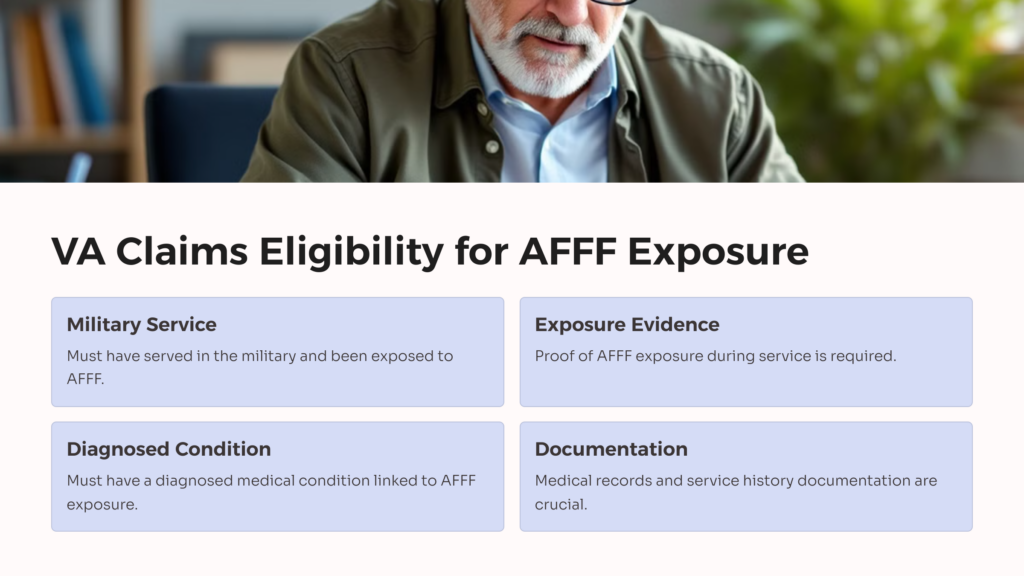
Veterans Affairs (VA) claims that Aqueous Film-Forming Foam (AFFF) exposure allows veterans to seek compensation and support for health issues resulting from their exposure to AFFF during military service. Administered by the Department of Veterans Affairs, this process involves assessing eligibility criteria, gathering evidence, and submitting a formal claim for review.
Eligibility Criteria for Veterans
Eligibility for VA claims related to AFFF exposure hinges on several factors. Veterans must have served in the military and been exposed to AFFF during their service. This exposure can occur through firefighting drills, handling AFFF containers, or proximity to areas where AFFF was used. Additionally, veterans must have a diagnosed medical condition or disability linked to their AFFF exposure, such as cancer, reproductive disorders, or immune system dysfunction.
The Claims Process
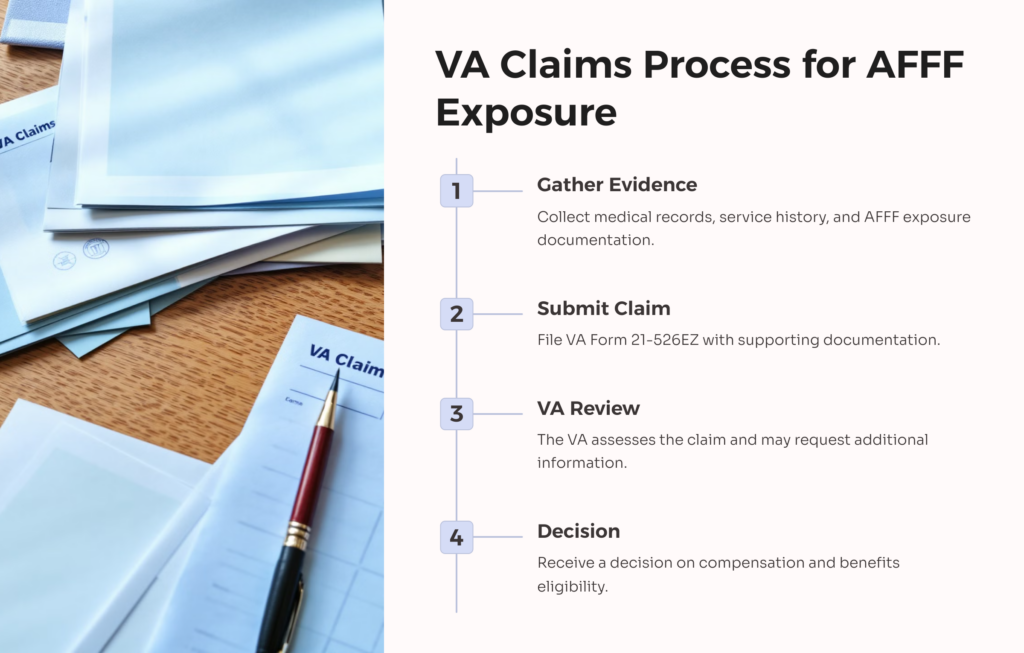
The claims process begins with veterans gathering relevant medical records, service records, and other documentation to support their claims. This evidence establishes a clear link between the veteran’s military service, AFFF exposure, and subsequent health issues. Veterans may undergo medical examinations or provide sworn statements from medical professionals to substantiate their claims further. Once the necessary documentation is gathered, veterans can submit their claims to the VA for review.
Required Forms
Commonly used for initiating the claims process is VA Form 21-526EZ “Application for Disability Compensation and Related Compensation Benefits.” This form collects basic information about the veteran’s service history, medical conditions, and supporting documentation. Additionally, veterans may need to submit supplementary forms or evidence specific to their AFFF exposure and related health issues.
Compensation and Benefits
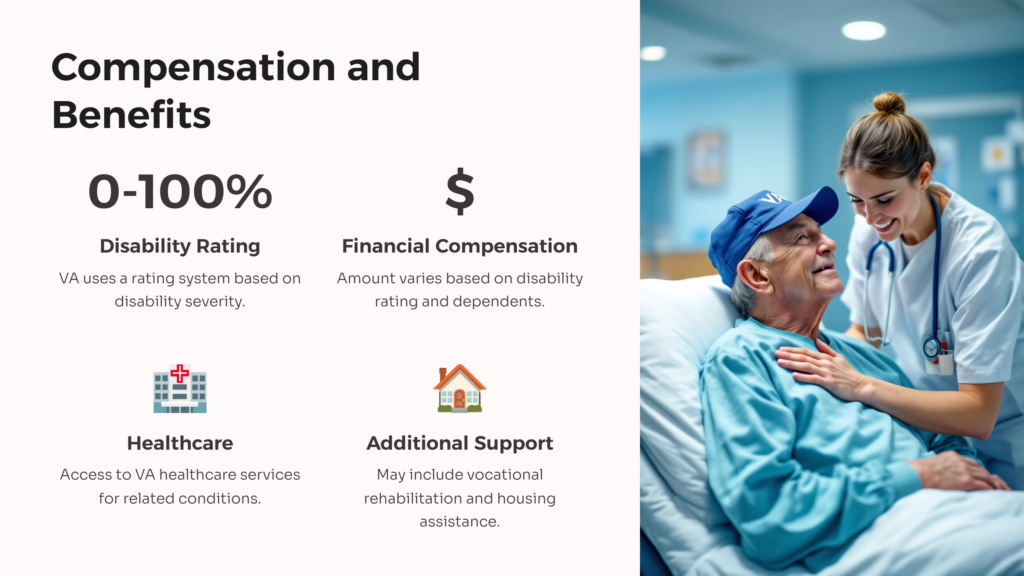
The compensation amount veterans can expect to receive varies depending on the severity of their medical conditions and disabilities. The VA uses a rating system based on disability severity, ranging from 0% to 100%. Veterans with higher disability ratings may be eligible for greater compensation benefits. In addition to financial compensation, veterans may receive healthcare, vocational rehabilitation, and housing assistance through the VA disability benefits.
VA claims for AFFF exposure provide veterans with a means to seek compensation and support for health issues resulting from their military service. Understanding the eligibility criteria, claim process, required forms, and potential compensation is essential for veterans navigating the VA claims system.
Case studies
Cai Cetera, a retired Army veteran, served for over 20 years and was exposed to AFFF during numerous firefighting drills and emergency response situations. Years after retiring from the military, Cai was diagnosed with prostate cancer, a condition linked to PFAS exposure from AFFF. John decided to file a VA claim for compensation and support.
Cai gathered medical records documenting his diagnosis, as well as evidence of his service history and exposure to AFFF. He submitted his claim along with VA Form 21-526EZ and supplementary documentation detailing his AFFF exposure and medical condition.
After a thorough review process, the VA approved his claim, recognizing the clear link between his military service, AFFF exposure, and subsequent health issues. John was awarded disability compensation and granted access to VA healthcare services to manage his cancer treatment.
Case Study 2: Unsuccessful VA Claim for AFFF Exposure
Melissa Johnson, a former Navy sailor, also sought compensation for health issues related to AFFF exposure during her military service. Despite experiencing symptoms consistent with PFAS exposure, such as thyroid dysfunction and reproductive issues, Sarah’s VA claim was initially denied.
The VA cited insufficient evidence linking Melissa’s health issues to her AFFF exposure, highlighting gaps in her medical records and service history documentation. Additionally, Sarah’s claim needed more detailed information about the extent and duration of her AFFF exposure, making it challenging for the VA to establish a clear causal relationship.
Melissa appealed the decision and worked with a veterans’ advocate to gather additional evidence and strengthen her case. With the help of medical experts and legal support, Sarah was able to provide compelling documentation to support a service connection, linking her health issues to AFFF military exposure.
Ultimately, Melissa’s persistence paid off, and her appeal was successful. The VA recognized the validity of her claim, and she was granted disability compensation and access to healthcare services to address her AFFF-related health issues.
Lessons Learned
Documentation is Key: Both successful and unsuccessful case studies emphasize the importance of thorough documentation. Veterans should gather comprehensive medical records, service history documentation, and evidence of AFFF exposure to support their claims effectively.
Seek Professional Assistance: Veterans facing challenges with their VA claims should seek assistance from veterans’ advocates, legal experts, or medical professionals specializing in AFFF-related health issues. These professionals can provide valuable guidance and support throughout the claims process.
Persistence is Vital: Receiving a denial from the VA does not necessarily mean the end of the road. Veterans can appeal decisions and present additional evidence to strengthen their cases. As Sarah’s case study demonstrated, persistence and determination can lead to successful outcomes.
Educate and Advocate: Awareness of AFFF-related health risks and advocacy for veterans’ rights are essential for driving policy changes and improving access to compensation and support services. Veterans, advocates, and policymakers should work together to ensure that those affected by AFFF exposure receive the assistance they deserve.
Successful VA claims for AFFF exposure require thorough documentation, professional assistance, persistence, and advocacy. By learning from successful and unsuccessful case studies, veterans can navigate the claims process more effectively and secure the compensation and support they need to address their AFFF-related health issues.
Recent Developments
In recent years, there have been notable developments in laws, guidelines, and investigations related to VA claims for Aqueous Film-Forming Foam (AFFF) exposure. These developments reflect ongoing efforts to address the health risks associated with PFAS exposure and improve support for affected veterans.
Legislative Action: Several bills have been introduced in Congress to address PFAS contamination and its impact on military personnel and veterans. These bills seek to enhance monitoring and regulation of PFAS chemicals, provide funding for cleanup efforts, and expand healthcare and compensation benefits for veterans affected by PFAS exposure.
VA Policy Updates: The Department of Veterans Affairs has updated its policies and guidelines to improve access to healthcare and compensation for veterans impacted by PFAS exposure. These updates include clarifications on eligibility criteria for VA claims related to AFFF exposure and streamlined processes for submitting and reviewing claims.
Research and Investigations: Ongoing research and investigations continue to shed light on the health effects of AFFF exposure and inform policy decisions. Studies are examining the prevalence of PFAS contamination in military installations, the long-term health effects of PFAS exposure, and potential mitigation strategies.
Legal Proceedings: Legal proceedings, including lawsuits and class-action settlements, are underway against manufacturers of AFFF products. These legal actions seek to hold manufacturers accountable for the health consequences of PFAS exposure and secure compensation for affected individuals, including veterans.
Public Awareness and Advocacy: Increased public awareness of PFAS contamination and its impact on communities, including military personnel and veterans, has led to more extraordinary advocacy efforts. Veterans’ organizations, advocacy groups, and concerned citizens are calling for stronger regulations, comprehensive healthcare coverage, and support for affected individuals.
Recent developments in laws, guidelines, investigations, and advocacy efforts reflect growing recognition of the need to address the negative effects of AFFF exposure and its impact on military personnel and veterans. These developments underscore the importance of ongoing research, policy reforms, and support services to mitigate the health risks associated with PFAS exposure and ensure that affected individuals receive the assistance they need.
Final Thoughts
Veterans who were exposed to AFFF during their military service may be eligible for compensation and support from the Department of Veterans Affairs.
To qualify for VA benefits, veterans must demonstrate a clear link between their military service, AFFF exposure, and subsequent health issues. The claims process involves gathering evidence, submitting a formal claim, and awaiting a decision from the VA.
Thorough documentation, including medical records and evidence of AFFF exposure, supports VA claims. Veterans may benefit from seeking assistance from veterans’ advocates, legal experts, or medical professionals specializing in AFFF-related health issues.
Veterans who suspect they may have been exposed to AFFF during their military service should prioritize their health and well-being. Seek medical evaluations for any symptoms or health issues related to AFFF exposure and consider filing a VA claim if eligible.
Take proactive steps to secure your health and potential claims related to AFFF exposure. By staying informed, seeking support, and advocating for their rights, veterans can ensure that they receive the compensation and support they deserve for the sacrifices they’ve made in service to their country.
 AllVeteran.com Advisors
AllVeteran.com Advisors
With expertise spanning local, state, and federal benefit programs, our team is dedicated to guiding individuals towards the perfect program tailored to their unique circumstances.








